#project lifecycle
Explore tagged Tumblr posts
Text
How does BIM benefit Stakeholders? Here’s an Estimate!
The world is envisaging a revolutionizing utilization of Building Information Modeling (BIM)! A couple of decades ago, the Architects, Engineers, Contractors and the various Stakeholders were mesmerized by enhanced profitability quotient, with the implementation of CAD Drafting and Design! Technology has taken massive strides since, and BIM evolved as a collaborative tool for digital…

View On WordPress
#pinnacleinfotech#Benefits of BIM#BIM#BIM and Stakeholders#pinnaclecad#Project Lifecycle#Revit#Stakeholders
0 notes
Text
Initiation Phase Mastery: Foundation for Project Success
Discover the secrets to mastering the initiation phase in project management! Learn how to ensure project success from the start. Don't miss out—read now and subscribe for more expert insights from Hafsa Reasoner on your Empowered Journey!
Mastering the Initiation Phase: The Key to Successful Project Management and a Source of Accomplishment. The initiation phase is not just a step in the project management process; it’s a key to successful project execution. Understanding and mastering this phase can be a source of great accomplishment in the project management journey. Project management, a crucial discipline involving…
#EmpoweredJourney#feasibilitystudies#HafsaReasoner#initiationphase#organizationalgoals#ProfessionalDevelopment#projectexecution#projectlifecycle#projectmanagement#projectsuccess#projectvalue#riskassessment#scopedefinition#stakeholderidentification#Empowered Journey#feasibility studies#Hafsa Reasoner#initiation phase#organizational goals#professional development#project execution#project lifecycle#project management#project success#project value#risk assessment#scope definition#stakeholder identification
0 notes
Text
i am struggling so hard with adjusting to my new workplace and it's mostly like because they have not been running me into the ground since day 1......
#kb is like it's just uncomfortable bc you're not used to your boss not using and abusing you#LIKE. oh no! am i that traumatized#who am i if i am not solely responsible for the entire lifecycle of one million projects!?!?#this is good in theory but i fr am having a smedium-sized crisis about it#like. how do i make good impression on team if i do not have actionable tasks yet?#this place is letting me have just like weeks to Read Research and Meet People and Learn About Things#which i suppose is known as 'onboarding' i am just not used to it#i am used to hitting the ground running diving straight in and having to own/lead everything#i am having culture shock i fear#even tho this is the exact type of culture that i wanted#anyway—!#driveby post#my lyfe
9 notes
·
View notes
Text
when u wanna read a yuri manhwa but it's only been translated into portuguese 😭
#no offense but why couldn't it be spanish.....#although the last gl manga i read in spanish was really testing me w fuckin business jargon#i do not care abt the project lifecycle (en español) i want to see these women fuck (en español)#why is every gl either schoolgirls or businesswomen
6 notes
·
View notes
Text
Worst thing about having taken business classes is that I see people complain about bullshit companies are pulling and a part of my brain goes "Oh, that's an effective tactic for cost reduction" or something around those lines. And then the part of my brain that is Not a wannabe businessman is just like "Bro."
#speculation nation#or anything on data management or anything like that. bfkshfmsbd#been learning about company perspectives and what have you. unfortunately i understand businesses more than i ever planned to.#such is the IT major at my school </3 i did already finish my business classes already#but im in data governance class now which deals a lot with the ways companies handle their data.#learning about policies and harm reduction tactics and data lifecycles and what have you#looking at the scaffolding of a company's data system and recognizing just how fragile it all is.#a side effect of all this is me feeling less angry about websites trying to make money.#advertisements and subscription services are aggravating. but hosting a website is *expensive*.#if they cant at least break even then the website is a resource drain and isnt sustainable in the long run.#not unless it's a damned passion project of a bigger conglomerate. and you'll find those are exceedingly rare.#so im annoyed by advertisements as much as the next person. but if theyre kept relatively unobtrusive then i dont mind them too much.#now ads that pop up to cover the whole screen. or god forbid youtube's unskippable 30+ second ads#THOSE are so obnoxious. the youtube ads especially.#had a few of those some weeks back when prepping my presentation that had me wanting to tear my hair out.#30+ seconds and NO SOUND EITHER. literally ridiculous.#anyways im definitely not a business sympathizer Especially when it comes to predatory practices#but for those more daily functions kinds of things... idk man sometimes these things just gotta happen.
3 notes
·
View notes
Text
Welcome To Twin Infra - Digtal Twin
A Digital Twin Platform to improve timeliness and reduce cost overruns in your construction projects.

Twin Infra is is a complete IT solution for the Construction/Infrastructure industry based on the concept of “Digital Twin.” The Twin Infra module is an integrated cloud platform to manage data models, people, process, and assets throughout the lifecycle of a construction project. The Twin Infra module has predictive analytic features to anticipate and forecast in all the stages of Construction/Infra. It works on public, private, and virtual cloud infrastructure and uses Artificial Intelligence for operational insights and efficiency.
Contact us
#digital twin#twininfra#Common Data Environment#Design Engineering#Building Lifecycle Management#Design Data Management#Construction Project Management#Construction Project Management software#Digital Construction Platform#Construction Data Management
2 notes
·
View notes
Text
Software Inventory & Compliance Management platform
Discover top-tier software inventory management and the best compliance management tools at Zionitai. Streamline operations with ease and precision.
inventory management software project
best compliance management software
IT Inventory Management
it asset lifecycle management
free inventory management software
#inventory management software project#best compliance management software#IT Inventory Management#it asset lifecycle management#free inventory management software
0 notes
Text
Sinclair ZX Spectrum Story - Birth of a Classic
"The ZX Spectrum is 35 years old on 23rd April 2017, and it also holds a very special place in my heart, so it's time to wish it a happy birthday... It's the machine I grew up with and which led me to creating this very channel. I've covered the Sinclair ZX Spectrum in the past, but frankly I didn't do it justice, so we're revisiting Sir Clive's iconic 8 bit home micro in detail, starting with The Sinclair Years in this two part documentary.
This first part explores Clive Sinclair's early years, from his childhood to the formation of Sinclair Radionics in 1961, through the mini amplifier period, pocket calculator, black watch and finally his range of computers, starting with the MK14 and culminating in the ZX Spectrum 128k. We'll look at the people involved behind the Spectrum such as Jim Westwood and Chris Curry and explore other avenues such as the famous punch up between Clive and Chris in a Cambridge pub. "
Source: Nostalgia Nerd
Also read:
" The Spectrum review – a tactile trip to the 1980s This latest piece of modern vintage hardware from Retro Games Ltd makes for an astonishingly nostalgic experience
The first time I played on a ZX Spectrum was at the Stockport branch of Debenhams, which in 1983 had an impressive home computer section that quickly turned into a sort of free creche for bored 13-year-old boys. You could hang out there for hours, typing rude Basic programs into an array of machines while the harried staff rushed about trying to stop them running. Some of the computers, however, ran games for customers to try – and this was where I encountered Manic Miner, the legendary platformer with its strange flashing visuals and surreal enemies. Speccy games looked utterly unique thanks to the machine’s idiosyncratic way of restricting 8x8 sprite maps to two colours, which meant moving objects on screen were usually collections of coloured pixel patchworks, leading to an effect known as attribute clash. Somehow, it was both ugly and beautiful – and it still is.
Unpacking The Spectrum, the latest piece of modern vintage hardware from Retro Games Ltd, is an astonishingly nostalgic experience. It looks exactly how I remember the original machine: a black slab with rubber keys, each one displaying not just a number or letter, but also a Basic programming command. “Rem”, “Rand”, “Gosub”, the mystical words of the home programming era. There is a USB cable to plug it in (though you’ll need a USB plug of your own) and an HDMI lead, but no joystick. The machine is compatible with most USB gamepads – you just need to configure the buttons yourself, which takes a little time but is worth it if you can’t bear using those rubber buttons to control your games.
Loading it up, you get a modern homescreen showing a carousel of built-in games. There are 48 to choose from, ranging from classics such as The Lords of Midnight, Head Over Heels, Manic Miner and The Hobbit, to modern titles produced by contemporary coders in the Speccy fan scene. These are fascinating projects, including top-down sci-fi blaster Alien Girl: Skirmish Edition and tomb raiding romp Shovel Adventure. If you exhaust the built-in supply, you can also download Spectrum game Roms from a PC on to a USB stick, plug it in and run them here – though if you’re looking for classic Speccy titles rather than modern open-source fan-made games, then you’re in shady legal territory. (Although two sites, World of Computing and Spectrum Computing, do run trustworthy archives of Spectrum game ROMs which are out of copyright.)
As ever, there are a bunch of screen settings so you can add a CRT effect to give a more authentic 1980s television experience, though honestly nothing is going to diminish the wild discombobulation of playing Horace Goes Skiing on a 55in LED display. What amazed me is how these games still carry so much visual charm. The pupils and masters wandering the halls of Skool Daze are filled with character, from the hulking bully to the decrepit history teacher. Sandy White’s Ant Attack retains its stark beauty, the geometric walls and scuttling giant ants providing the same old sense of alienation and terror. Ocean’s relatively sophisticated isometric adventures The Great Escape and Where Time Stood Still pack so much detail into their largely monochrome worlds. It is lovely to see them again.
As with most other retro consoles, there are modern gaming additions such as save points (a little finicky to work, but they do the job) and a rewind function that whizzes you back to seconds before you were inevitably run over by a car in Trashman. But I also love the fact that each time you select a game you get a few seconds of the original illustrated loading screen; these pictorial delights were a key part of the initial experience as you’d be staring at them for up to five minutes as you waited for your tape to finally load – it matters that they have been preserved.
Also preserved are the original computing abilities of the ZX Spectrum. If you select the classic mode, the console switches to ye olde worlde boot screen and you can actually program it. It’s a feature I have taken full advantage of.
Who is this for? Obviously the target audience is people like me who were there at the beginning and remember playing a lot of these games 40 years ago. Sure, there are free Spectrum emulators available online if you know where to look. But part of the nostalgic gaming experience is seeing a reproduction of the machine you remember sitting in front of your TV; and with The Spectrum you also get those legendary rubber buttons, feeling them squidge beneath your fingers as you hammer the leg sweep button in The Way of the Exploding Fist.
In the digital age we sometimes forget how much of memory is about feel. Many of these games were designed with keyboard controls in mind as joysticks were an optional extra and out of the price range of a lot of families in the early 1980s. The Spectrum revels in the tactile appeal of this seminal computer and its springy buttons. It will remind you of how odd Speccy games were, and how they forged their own path beyond the Japanese arcades and flashy American home computers. The days of hanging out in the computer department of Debenhams all Saturday afternoon are long gone, but the games, and the way we played them, are here again. You can come back any time you like.
The Spectrum is available now, £89.99
This article was amended on 11 December 2024. An earlier version indicated that it was difficult to find places to legally download classic Spectrum games; this reference has been updated, and details provided of two places where it is possible to do this."
Source: theguardian.com /games / 2024
#mktmarketing4you #corporatestrategy #marketing #M4Y #lovemarketing #IPAM #ipammarketingschool #ContingencyPlanning #virtual #volunteering #project #Management #Economy #ConsumptionBehavior #BrandManagement #ProductManagement #Logistics #Lifecycle #Brand #Neuromarketing #McKinseyMatrix #Viralmarketing #Facebook #Marketingmetrics #icebergmodel #EdgarScheinsCultureModel #GuerrillaMarketing #STARMethod #7SFramework #gapanalysis #AIDAModel #SixLeadershipStyles #MintoPyramidPrinciple #StrategyDiamond #InternalRateofReturn #irr #BrandManagement #dripmodel #HoshinPlanning #XMatrix #backtobasics #BalancedScorecard #Product #ProductManagement #Logistics #Branding #freemium #businessmodel #business #4P #3C #BCG #SWOT #TOWS #EisenhowerMatrix #Study #marketingresearch #marketer #marketing manager #Painpoints #Pestel #ValueChain # VRIO #marketingmix #spectrum
Thank you for following All about Marketing 4 You
youtube
#mktmarketing4you#corporatestrategy#marketing#M4Y#lovemarketing#IPAM#ipammarketingschool#ContingencyPlanning#virtual#volunteering#project#Management#Economy#ConsumptionBehavior#BrandManagement#ProductManagement#Logistics#Lifecycle#Brand#Neuromarketing#McKinseyMatrix#Viralmarketing#Facebook#Marketingmetrics#icebergmodel#EdgarScheinsCultureModel#GuerrillaMarketing#STARMethod#7SFramework#gapanalysis
1 note
·
View note
Text
Efficient Solutions with One Call Ticket Management for Streamlined Operations
Explore seamless operations and optimized workflows with Norfield's "One Call Ticket Management" solutions. At Norfield Development Partners, we focus on providing a fully integrated ticket management system that enhances safety, communication, and compliance for businesses managing underground utility projects. Our "One Call Ticket Management" service simplifies complex processes, ensuring that all utility locate requests and notifications are handled accurately and on time.
Our user-friendly system is designed to automate key aspects of ticket management, from receiving and processing One Call tickets to dispatching locate technicians and generating compliance reports. By integrating with existing operational platforms, Norfield’s solutions minimize manual data entry, improve data accuracy, and help avoid costly errors associated with delayed or mishandled tickets.
Norfield’s "One Call Ticket Management" solution is built to empower utility operators, municipalities, contractors, and other stakeholders with greater control over their locate requests and responses. Featuring real-time tracking, automated workflows, and data synchronization, our system promotes operational efficiency while ensuring all stakeholders are informed throughout each stage of the ticket lifecycle.
For businesses looking to streamline operations, reduce risk, and enhance service quality, Norfield's "One Call Ticket Management" provides a comprehensive answer. Our solutions not only facilitate faster response times but also improve compliance with local and state regulations, helping to avoid fines and operational disruptions.
#One Call ticket management#utility locate requests#Norfield ticket management solutions#underground utility project management#locate technician dispatch#ticket lifecycle tracking
0 notes
Text
Top 10 ChatGPT Prompts For Software Developers
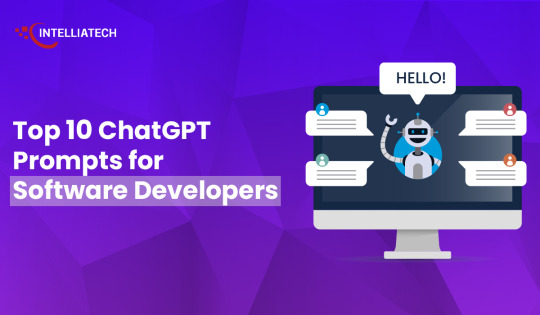
ChatGPT can do a lot more than just code creation and this blog post is going to be all about that. We have curated a list of ChatGPT prompts that will help software developers with their everyday tasks. ChatGPT can respond to questions and can compose codes making it a very helpful tool for software engineers.
While this AI tool can help developers with the entire SDLC (Software Development Lifecycle), it is important to understand how to use the prompts effectively for different needs.
Prompt engineering gives users accurate results. Since ChatGPT accepts prompts, we receive more precise answers. But a lot depends on how these prompts are formulated.
To Get The Best Out Of ChatGPT, Your Prompts Should Be:
Clear and well-defined. The more detailed your prompts, the better suggestions you will receive from ChatGPT.
Specify the functionality and programming language. Not specifying what you exactly need might not give you the desired results.
Phrase your prompts in a natural language, as if asking someone for help. This will make ChatGPT understand your problem better and give more relevant outputs.
Avoid unnecessary information and ambiguity. Keep it not only to the point but also inclusive of all important details.
Top ChatGPT Prompts For Software Developers
Let’s quickly have a look at some of the best ChatGPT prompts to assist you with various stages of your Software development lifecycle.
1. For Practicing SQL Commands;

2. For Becoming A Programming Language Interpreter;

3. For Creating Regular Expressions Since They Help In Managing, Locating, And Matching Text.

4. For Generating Architectural Diagrams For Your Software Requirements.
Prompt Examples: I want you to act as a Graphviz DOT generator, an expert to create meaningful diagrams. The diagram should have at least n nodes (I specify n in my input by writing [n], 10 being the default value) and to be an accurate and complex representation of the given input. Each node is indexed by a number to reduce the size of the output, should not include any styling, and with layout=neato, overlap=false, node [shape=rectangle] as parameters. The code should be valid, bugless and returned on a single line, without any explanation. Provide a clear and organized diagram, the relationships between the nodes have to make sense for an expert of that input. My first diagram is: “The water cycle [8]”.

5. For Solving Git Problems And Getting Guidance On Overcoming Them.
Prompt Examples: “Explain how to resolve this Git merge conflict: [conflict details].” 6. For Code generation- ChatGPT can help generate a code based on descriptions given by you. It can write pieces of codes based on the requirements given in the input. Prompt Examples: -Write a program/function to {explain functionality} in {programming language} -Create a code snippet for checking if a file exists in Python. -Create a function that merges two lists into a dictionary in JavaScript.
7. For Code Review And Debugging: ChatGPT Can Review Your Code Snippet And Also Share Bugs.
Prompt Examples: -Here’s a C# code snippet. The function is supposed to return the maximum value from the given list, but it’s not returning the expected output. Can you identify the problem? [Enter your code here] -Can you help me debug this error message from my C# program: [error message] -Help me debug this Python script that processes a list of objects and suggests possible fixes. [Enter your code here]
8. For Knowing The Coding Best Practices And Principles: It Is Very Important To Be Updated With Industry’s Best Practices In Coding. This Helps To Maintain The Codebase When The Organization Grows.
Prompt Examples: -What are some common mistakes to avoid when writing code? -What are the best practices for security testing? -Show me best practices for writing {concept or function} in {programming language}.
9. For Code Optimization: ChatGPT Can Help Optimize The Code And Enhance Its Readability And Performance To Make It Look More Efficient.
Prompt Examples: -Optimize the following {programming language} code which {explain the functioning}: {code snippet} -Suggest improvements to optimize this C# function: [code snippet] -What are some strategies for reducing memory usage and optimizing data structures?
10. For Creating Boilerplate Code: ChatGPT Can Help In Boilerplate Code Generation.
Prompt Examples: -Create a basic Java Spring Boot application boilerplate code. -Create a basic Python class boilerplate code
11. For Bug Fixes: Using ChatGPT Helps Fixing The Bugs Thus Saving A Large Chunk Of Time In Software Development And Also Increasing Productivity.
Prompt Examples: -How do I fix the following {programming language} code which {explain the functioning}? {code snippet} -Can you generate a bug report? -Find bugs in the following JavaScript code: (enter code)
12. Code Refactoring- ChatGPt Can Refactor The Code And Reduce Errors To Enhance Code Efficiency, Thus Making It Easier To Modify In The Future.
Prompt Examples –What are some techniques for refactoring code to improve code reuse and promote the use of design patterns? -I have duplicate code in my project. How can I refactor it to eliminate redundancy?
13. For Choosing Deployment Strategies- ChatGPT Can Suggest Deployment Strategies Best Suited For A Particular Project And To Ensure That It Runs Smoothly.
Prompt Examples -What are the best deployment strategies for this software project? {explain the project} -What are the best practices for version control and release management?
14. For Creating Unit Tests- ChatGPT Can Write Test Cases For You
Prompt Examples: -How does test-driven development help improve code quality? -What are some best practices for implementing test-driven development in a project? These were some prompt examples for you that we sourced on the basis of different requirements a developer can have. So whether you have to generate a code or understand a concept, ChatGPT can really make a developer’s life by doing a lot of tasks. However, it certainly comes with its own set of challenges and cannot always be completely correct. So it is advisable to cross-check the responses. Hope this helps. Visit us- Intelliatech
#ChatGPT prompts#Developers#Terminal commands#JavaScript console#API integration#SQL commands#Programming language interpreter#Regular expressions#Code debugging#Architectural diagrams#Performance optimization#Git merge conflicts#Prompt engineering#Code generation#Code refactoring#Debugging#Coding best practices#Code optimization#Code commenting#Boilerplate code#Software developers#Programming challenges#Software documentation#Workflow automation#SDLC (Software Development Lifecycle)#Project planning#Software requirements#Design patterns#Deployment strategies#Security testing
0 notes
Text
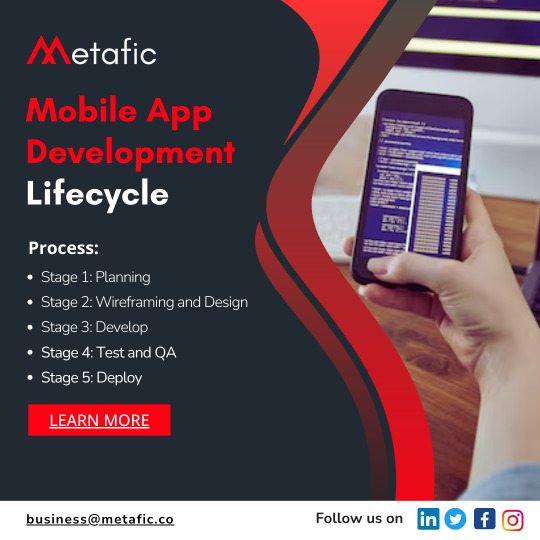
A guide to mobile app development lifecycle process - Metafic
Feeling lost in the mobile app development world? Metafic offers a clear, step-by-step guide to the entire mobile app development lifecycle process. Understand each stage, make informed decisions, and launch your app with confidence. Get started today!
#Mobile App Development#mobile app development lifecycle#project management process#development life cycle#mobiledevelopment#mobile app development company
0 notes
Text
I, like many people, imagine that Ryland Grace included many personal notes and thoughts in the information he sent back to Earth, but it has just occurred to me that there is an even funnier version of this.
Decades or centuries after humanity was saved, after they received a clear and concise but impersonal data dump about the astrophage lifecycle + the Eridians and Ryland has faded into a martyred historical figure that no one bothers to learn much about personally, humanity finally mounts a trip to visit the home planet of the species that helped save them all.
When they arrive they are immediately hit in the face with Ryland Grace's thesis-length tell-all memoir that he spent the rest of his life working on (with the expectation of this very event) and all the Earth historians just have to deal with all this new unedited data because you KNOW some weird Earth government decided to sanitize most of the actual info about how the project worked for publicity or something and so no one was really aware of what all went down during the potential End of the World.
279 notes
·
View notes
Text
Alien Questionnaire - A Biological Perspective
A while ago, somebody linked me a very comprehensive worldbuilding questionnaire. For most aspects of a fictional society, it was great, but I noticed it assumed that anyone using it was making up a fictional human society, or at least a society of beings very similar to humans. As such, there was almost nothing in the biology department, which to me is one of the best parts! Thus, this questionnaire was born.
These questions are designed to help people worldbuild from a biological foundation. As such, the questionnaire only touches lightly on other aspects of a fictional society, and is more of a jumping off point. I wrote it with the aim of using it to develop aliens, but it should be suitable for any project with non-humanoid species, such as sapient terrestrial animals.
Have fun! I'd love to see your answers :)
------------------------------------------------------------------------------
General Anatomy How many limbs do they have? Do they have limbs at all?
What are their primary manipulators? Where are they located? How does this affect their tool use, building ability, etc?
What kind of body covering do they have, e.g. hair, scales, feathers? How do they clean it? Do they shed this covering constantly, or all at once at certain times?
Can they maintain a constant body temperature? If not, how do they deal with changing environmental temperatures?
What kind of habitat do they live in? Both specific habitat, and broader such as on land vs in water.
What adaptations do they have for living in this habitat?
What kind of creature did they evolve from?
What are the similarities and differences to their closest living relatives?
What resource(s) is the most necessary and urgent for them? E.g. for many animals, but not all, it’s water.
What are some common mutations? E.g. eye colours, ability to digest lactose in humans.
What injuries or illnesses are considered disabling?
How is their healing ability? Can they regenerate? If they can, is that limited to certain body parts or a certain number of times?
Senses What senses do they have? E.g. sight, smell, electroreception, etc.
How good are those senses?
Which of their sense/s do they use the most in everyday life?
How might this choice of sense impact the way they interact with the world?
Can they detect things that Earth creatures cannot? If yes, how and why?
Movement How do they move? Do they walk, crawl, fly, etc?
If they have multiple modes of movement, which is preferred, and why?
Which part/s of their body do they use to move?
What is their speed and endurance like?
How agile are they?
Do they rely mainly on their own bodies for travel, or do they use pack animals and machines?
How often do they move around? Are they mainly sedentary, do they move a lot within a set area, do they migrate, etc?
Do they have different levels of mobility depending on age, sex, or other biological group? E.g. young barnacles are able to swim, while adults are anchored permanently to a surface.
Reproduction and Lifecycle How many sexes are there?
Are there differences between the sexes (ignoring the reproductive system)?
Are there different castes, such as in honeybees or naked mole rats? If so, what is the function of each caste?
Are differences in sex or caste used to justify discrimination or hierarchy? How might these ideas differ in different populations?
Do they have a concept of gender? If so, is gender affected by sex, caste, or some other factor?
How do they attract a mate? Do they release a chemical into the air, do an elaborate display, etc?
Does one individual try to actively woo another, or is courtship more mutual?
What do they find attractive in members of the same species?
What is the usual reproductive partnership? E.g. two individuals, one main reproducing individual with a harem, no set partner, etc.
How long do they live?
How are young brought into the world? Live birth, eggs, spores, etc?
Is producing young a painful, dangerous process, or is it easy?
How much parental investment is there? Are there many young with little investment, or few young with a lot of investment (r vs K strategy)? Or is it somewhere in the middle?
How many offspring are produced at a time? Think about how attitudes towards children may differ between a species that produces one or two, and a species that produces dozens or even hundreds at a time.
How do they grow? Are they born looking like miniature adults, gradually growing bigger? Do they have specific phases of high growth, like puberty? Do they have a larval phase, metamorphosis?
How self-sufficient are they as young? Can they move around and feed themselves as soon as they are born? Do they require parental care?
What is the usual structure of childcare? Single or multiple parents/related individuals? Communally raised?
Is sex purely for reproduction, or does it serve other purposes?
What kind of sexuality is considered the norm? This doesn’t just refer to same/other sex pairings, but the culture around sex in general.
Diet and Foodchain What is their diet? Are they carnivores, omnivores, frugivores, insectivores, etc?
Do they feed off an unusual source, for example rocks, metals, or (in appropriate settings) something like magic or souls?
What physical adaptations do they have for this diet?
Is their diet very restricted, or can they have a wide range of foods?
How often do they eat? What is the culture around mealtimes, if any?
Are they prey for other organisms? For each other?
If they are, how do they deal with it? Do they fight back, have barriers, or do they accept it as a part of life?
If they are hunters themselves, what is their attitude to killing other organisms? Are they respectful? Prideful of their kill? Is it completely trivial?
If they are hunters, how do they hunt? Are they solitary or packhunters? Are certain members of the group designated to hunt?
Are the results of foraging or hunting shared, or is it everyone for themself?
Are they parasitic, parasitised, or in a symbiotic relationship with any other organisms?
Body Rhythms How often do they sleep?
What time of the day are they most active? Are they nocturnal, diurnal, crepuscular?
Do they generally sleep for one long period a day, multiple shorter periods throughout, or something in between?
Do they sleep to cope with extreme temperatures or bad conditions, i.e. hibernate or aestivate?
Do they have any biological processes that disrupt their life e.g. moulting, reproductive cycles, etc?
If yes, how does their society accommodate for these processes? Does it accommodate them at all?
Communication What is their main method of communication? Sound, visuals, scent, etc? Think about their main sense and how this would affect communication.
What is their body language like? What small moving parts might aid their body language?
If they have multiple methods of communication, are they all given equal weight, or is one considered higher than others?
Society How sociable are they?
If social, what is the usual social structure?
Are there hierarchies? How strict or relaxed are the roles?
How are disputes usually settled? Is it more common to be violent or appease the other party?
If not social, what is the reaction to being with other individuals? Do they become aggressive or stressed? Do they tolerate each other?
What is the usual size of a community? Do they have communities at all?
Do they have an in-group vs out-group mentality? If so, how strong is it? This generally relates to how scarce or plentiful resources were during their evolution, and how territorial their ancestors were.
What kind of bonds do they form?
On the spectrum of individualistic to community-oriented, where do they fall?
Do they have a strong sense of personal identity? Think about how this might tie in with the previous question.
What are the main things they derive identity from? Occupation, gender, family ties, etc?
Do they have names? If yes, how are these names formed? Are they given by another party or chosen by the individual?
Have they domesticated any creatures? If so, what do they use these creatures for?
Do they have any unusual relationships with other creatures on their planet (beyond predation, parasitism or mutualism)?
Do they produce art? What are their main forms of artistic expression? Think about how this will be linked to their main sense(s), communication method, and/or primary manipulators.
------------------------------------------------------------------------------
GLOSSARY Primary manipulator: Main body part used to manipulate objects, e.g. hands in humans, trunks in elephants, feet in parrots.
Sedentary: Inactive, staying in the same place.
Caste (reproductive): A group within a species with differences in body type and reproductive ability.
Symbiosis/Mutualism: Interactions where both parties benefit, e.g. cleaner fish getting a meal in exchange for picking irritating parasites off larger fish.
Aestivate: To become inactive during hot or dry periods, usually involving being sealed in mucus or soil e.g. lungfish, snails.
Reproductive cycle: Regular hormone fluctuations that affect an animal’s fertility or attitude towards breeding. The cycles can range from months to years and can include things such as antler growth in male deer, heat cycles, and menstruation in humans.
#worldbuilding#biology#zoology#speculative evolution#speculative biology#spec evo#spec bio#alien#questionnaire#xenobiology
2K notes
·
View notes
Text
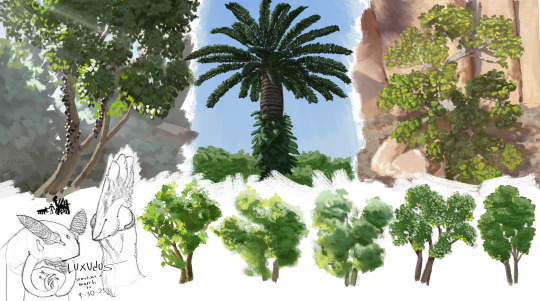
PLANT STUDIES! all the way back in February I wanted to explore the anatomy and evolution of Irou's plant-life to differentiate them from earth plants. which led me down the rabbit hole of Speculative Botany and early plant evolution. Which led me out of that rabbit hole and into studying how to draw plants in general. Which is where I am now.
The bottom quintet of trees is from when I was actually figuring out how to even paint foliage progressing from left to right.
The top trio of trees were referenced from a set of photos I took at a Botanical Garden I went to back in march. Some friends helped me identify the first two trees being a Jabuticaba and possibly a day palm tree. The last plant I hadn't verified yet but I'm pretty sure it might be a jade plant/money tree (Crassula ovata) or at least a plant in that genus.
And lastly to throw a bone to the people here for my spec-bio. In the bottom left are two sophont sketches from my side project A Story of Our Universe. What do they share in common? Evolutionary speaking they're both more plant than animal.
The first sophont (left) we don't properly know their real name, we just call them Nightwalkers. Everything we will come to know about them comes from evesdropping on radio communication between various members of the Intergalactic community. What we will know though is that the Nightwalkers first evolved a staggering 8 billion years ago, during the very tail end of the first age of sapience.
They were one of the few Sophonts at the time to reach the stars completely on their own. And were one of the very few to be Initiators in first contact with the Eldest sophonts; the Factorem and Bellators. They lived their lives out their little corner of space, just outside the Hercules-Corona-Borealis great wall, some 10 billion light years away from us. They would eventually go extinct some 2-3 billion years ago, fizzling out in the aftermath of the Eldest Alliance's Death throes.
They evolved on a cold, dark, and damp planet that sat on the frost line of their sun's habitable zone. A World so dark it was said you could still see the stars even on the brightest of days, Which is where our name for them came from. The Nightwalkers themselves evolved from a kind of motile vine-like algae. which over hundreds of millions of years evolved bilateral symmetry, Hydraulic muscles and compound eyes from light sensitive leaves. They still retain plenty of floral features, cells with walls and vacuoles, A circulatory system derived from a "xylem and phloem". And an alternating life generation cycle of "Gametophyte" and "sporophyte" sexes.
The second sophont (right) we will come to know alot about. They aren't from some distant galaxy or lived and died before anything on our planet consisted of more than one cell. And we wouldn't hear them from the distant radio chatter of unimaginably larger civilizations. On the grander scale of the universe, the Thau'Lix evolve right on our backyard. They would be the only other sapient species to hail from the orion spur of our milky way galaxy.
Evolving on a ringed tropical planet covered in rainforests and geographically teeming with waterfalls. The Thau'lix evolutionary speaking, are also a form of plant native to their homeworld. Unlike the Nightwalkers who are as far removed from them as we are from the neotenous young of sponges. The Thau'lix are still very much a form of plant. Their lifecycle is split into two, the form you see here is derived from walking seeds, given hundreds of years of speciation to convergently evolve an animal-like form, an almost angelic one at that. They graciously soar their entire planet on 2 pairs of wings, foraging for fruits, leaves, and small prey, both of the walking seed and true "animal" varieties. And eventually for suitable ground to settle down and re-emerge into their adult form as a fast-growing trees that branch like chandeliers with Arcuate-veined Truncate-shaped leaves that take on a familiar green pigment.
It will take 100,000 years for us to make contact with the Thau'lix. By that time Our governments, cultures, languages and religions will have become near unrecognizable from what they are today. We will have explored and settled across thousands of worlds like home, all across the entire orion spur, we will have mastered our little corner of space. While the Thau'lix would be in their own paleolithic age, living in airbound nomadic hunter-gatherer communities. We are to them what the Eldest Sophonts were to the Nightwalkers, We will be their godlike benefactors. And they will see us as gods, deities of the night sky gifted with eternal youth, divine seedlings that will never age and sprout into our own trees. We would come to share with them bits and pieces of our culture and way of life that will change their future. We will become friends for centuries, and without warning we will disappear. We will tell them to keep the memories of us in their hearts, Carry on our torch, and to not shout into the cold quiet night, lest they hear them too.
Just like that they will be alone once more, we will be remembered as their gods, and only as gods, for at least a while. They will have to overcome their own problems and revelations. They'll learn not to fall for leaders with big claims and bigger desires for absolute power. They will explore the rest of the galaxy only to find that everything trailing their home planet is seemingly missing of habitable worlds, a great hole of planet-bound colonization. And they will eventually learn about the true nature of their old gods, and have to come to terms that the Ancient Alien conspiracy theorists were fucking right all along.
The Thau'lix will carry the torch, the spirit, of humanity. Not us, not anymore.
#my art#artist on tumblr#art#speculative biology#alien species#worldbuilding#sophont#plants#art study#tree art#plant art
63 notes
·
View notes
Note
https://www.tumblr.com/tacobout911/778012877414072320/potential-lou?source=share
I want to call out how perfectly this illustrates the lifecycle of BoB outrage. Since Tommy reappeared, there's been nonstop speculation that the cast hates Lou. Posts about this, with absolutely no substantiation, regularly get 1000+ likes and reposts.
Meanwhile, if you actually pay attention, everyone seems to like him. Random day players have posted pictures about how sweet he is to work with. Aisha thinks he's a sweetie. Kenny hangs out with him socially. Oliver talks about him positively. He and Ryan get along great.
So there's BoB reality in which an entire group has convinced themselves of something with absolutely no merit to it. To the point that, a full year later, they're tagging random shadows with captions about how hated Lou is.
What part of "media literacy" does this fall under?
Self-projection.
54 notes
·
View notes
Text
I fucking love boxworms and fire sprites
they might as well be the closest extant cousin of iterators
a photoplasmic brain with a steam producing body/nest, the similarities to overseers (and even neurons to an extent) is undeniable

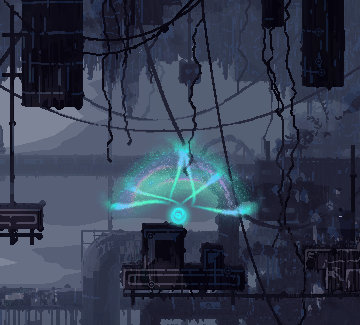

(thank you @iteratorsex for the overseer gif, all other gifs in this post are from the wiki)
you can see them gathering resources (dust (for food? definetively for growing the boxworm) and potentially water or at least hydrogen and oxygen) like a jellyfish or perhaps a sponge (the way it opens and closes its mouth is very cute too)
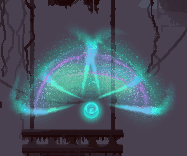
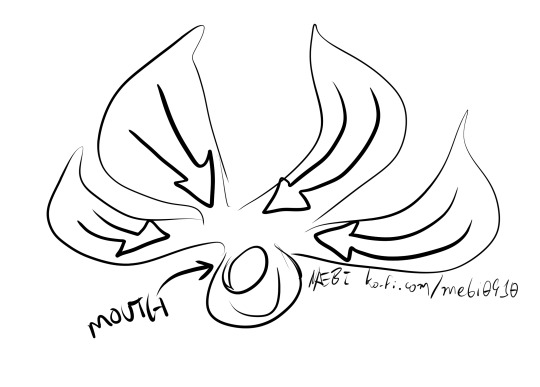
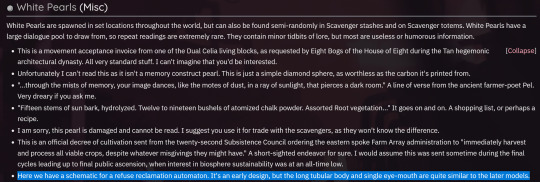
Here we have a schematic for a refuse reclamation automaton. It's an early design, but the long tubular body and single eye-mouth are quite similar to the later models.
mmm, interesting
btw the way the tendrils unfurl into conveyor fans here remind me of a theory ive had that overseers deploy a thin membrane in order to project holograms to
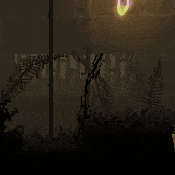
the boxworm is a body actioned through pneumatics and also a host for the eggs to grow in
the activation animation is very fun (are those glass windows in the box "eyes"?)
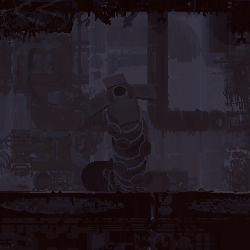
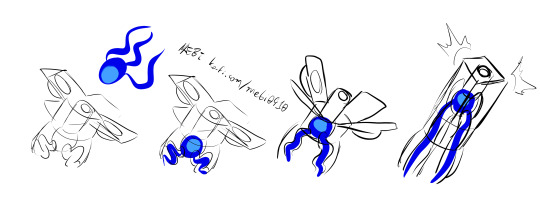
is the water gathered by the fire sprite? or is it created by combining hydrogen and oxygen? if the latter, would these gasses be collected or synthesized through organic processes? either way it serves the same function as hemolymph in spider legs, even if the shape is worm-like
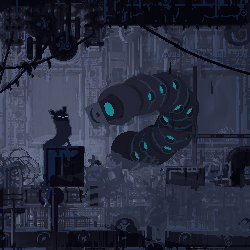

soft robotics comes to mind (here's another example)
talking about the eggs, i wonder what's the lifecycle like? do the fire sprites grow their own boxworm from zero? slowly from gathered dust? or is this an intestinal worm situation, and each boxworm segment eventually separates once its corresponding fire sprite matures?

now, the structure of the boxworm and the fire sprite larva situation has made me realize a possibility that would have me reconsider and in a way complete my iterator biota lifecycle theory:
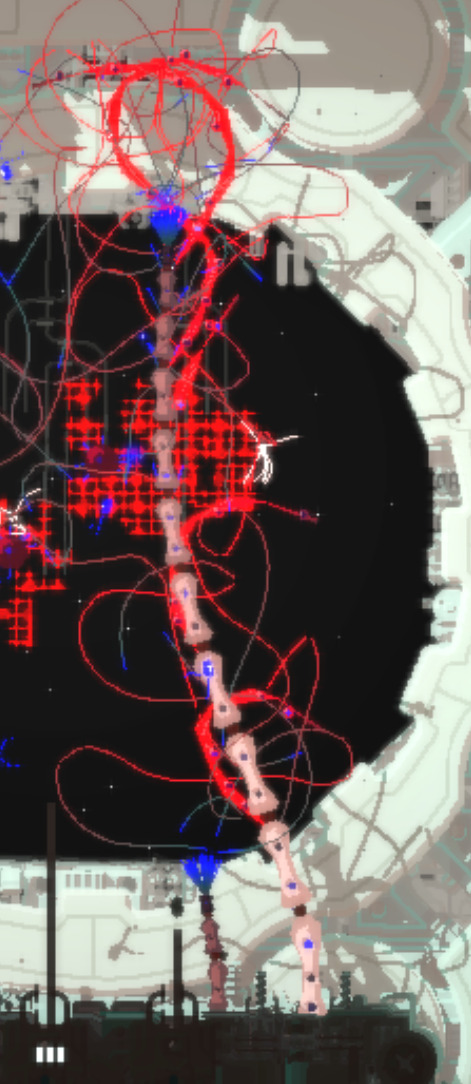
coral stems are segmented with little balls/openings, kinda like the boxworm in a way
while coral stems are bundles of mycelia and a number of small flashing cores sheathed on self-grown shells, it is possible neuronflies and overseers are grown from these flashing dots
after all, coral neurons already grow out of these stems
31 notes
·
View notes